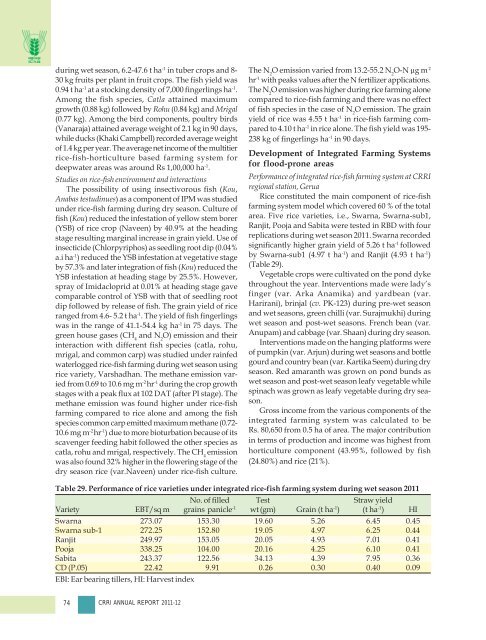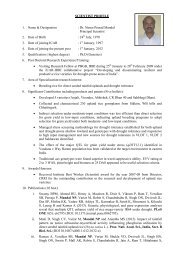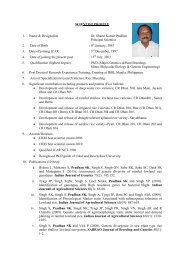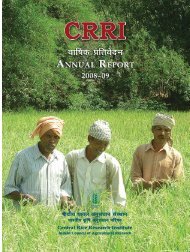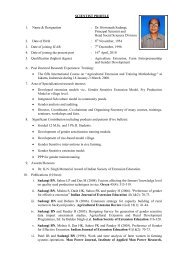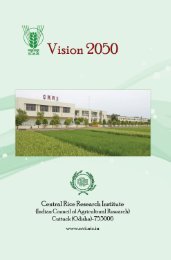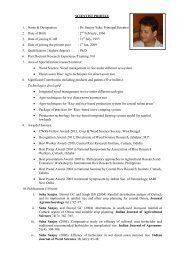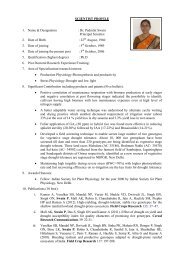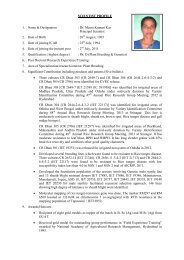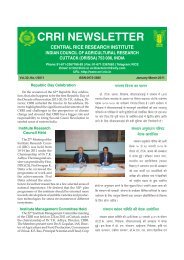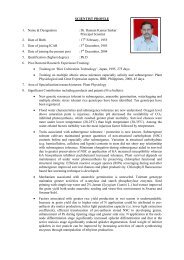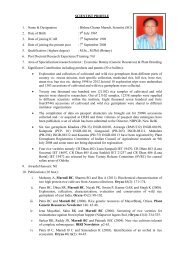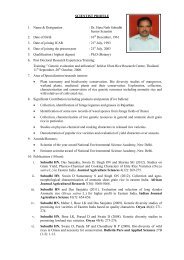Central Rice Research Institute Annual report...2011-12
Central Rice Research Institute Annual report...2011-12
Central Rice Research Institute Annual report...2011-12
You also want an ePaper? Increase the reach of your titles
YUMPU automatically turns print PDFs into web optimized ePapers that Google loves.
during wet season, 6.2-47.6 t ha -1 in tuber crops and 8-<br />
30 kg fruits per plant in fruit crops. The fish yield was<br />
0.94 t ha -1 at a stocking density of 7,000 fingerlings ha -1 .<br />
Among the fish species, Catla attained maximum<br />
growth (0.88 kg) followed by Rohu (0.84 kg) and Mrigal<br />
(0.77 kg). Among the bird components, poultry birds<br />
(Vanaraja) attained average weight of 2.1 kg in 90 days,<br />
while ducks (Khaki Campbell) recorded average weight<br />
of 1.4 kg per year. The average net income of the multitier<br />
rice-fish-horticulture based farming system for<br />
deepwater areas was around Rs 1,00,000 ha -1 .<br />
Studies on rice-fish environment and interactions<br />
The possibility of using insectivorous fish (Kou,<br />
Anabas testudinues) as a component of IPM was studied<br />
under rice-fish farming during dry season. Culture of<br />
fish (Kou) reduced the infestation of yellow stem borer<br />
(YSB) of rice crop (Naveen) by 40.9% at the heading<br />
stage resulting marginal increase in grain yield. Use of<br />
insecticide (Chlorpyriphos) as seedling root dip (0.04%<br />
a.i ha -1 ) reduced the YSB infestation at vegetative stage<br />
by 57.3% and later integration of fish (Kou) reduced the<br />
YSB infestation at heading stage by 25.5%. However,<br />
spray of Imidacloprid at 0.01% at heading stage gave<br />
comparable control of YSB with that of seedling root<br />
dip followed by release of fish. The grain yield of rice<br />
ranged from 4.6- 5.2 t ha -1 . The yield of fish fingerlings<br />
was in the range of 41.1-54.4 kg ha -1 in 75 days. The<br />
green house gases (CH 4<br />
and N 2<br />
O) emission and their<br />
interaction with different fish species (catla, rohu,<br />
mrigal, and common carp) was studied under rainfed<br />
waterlogged rice-fish farming during wet season using<br />
rice variety, Varshadhan. The methane emission varied<br />
from 0.69 to 10.6 mg m -2 hr -1 during the crop growth<br />
stages with a peak flux at 102 DAT (after PI stage). The<br />
methane emission was found higher under rice-fish<br />
farming compared to rice alone and among the fish<br />
species common carp emitted maximum methane (0.72-<br />
10.6 mg m -2 hr -1 ) due to more bioturbation because of its<br />
scavenger feeding habit followed the other species as<br />
catla, rohu and mrigal, respectively. The CH 4<br />
emission<br />
was also found 32% higher in the flowering stage of the<br />
dry season rice (var.Naveen) under rice-fish culture.<br />
The N 2<br />
O emission varied from 13.2-55.2 N 2<br />
O-N g m 2<br />
hr -1 with peaks values after the N fertilizer applications.<br />
The N 2<br />
O emission was higher during rice farming alone<br />
compared to rice-fish farming and there was no effect<br />
of fish species in the case of N 2<br />
O emission. The grain<br />
yield of rice was 4.55 t ha -1 in rice-fish farming compared<br />
to 4.10 t ha -1 in rice alone. The fish yield was 195-<br />
238 kg of fingerlings ha -1 in 90 days.<br />
Development of Integrated Farming Systems<br />
for flood-prone areas<br />
Performance of integrated rice-fish farming system at CRRI<br />
regional station, Gerua<br />
<strong>Rice</strong> constituted the main component of rice-fish<br />
farming system model which covered 60 % of the total<br />
area. Five rice varieties, i.e., Swarna, Swarna-sub1,<br />
Ranjit, Pooja and Sabita were tested in RBD with four<br />
replications during wet season 2011. Swarna recorded<br />
significantly higher grain yield of 5.26 t ha -1 followed<br />
by Swarna-sub1 (4.97 t ha -1 ) and Ranjit (4.93 t ha -1 )<br />
(Table 29).<br />
Vegetable crops were cultivated on the pond dyke<br />
throughout the year. Interventions made were lady’s<br />
finger (var. Arka Anamika) and yardbean (var.<br />
Harirani), brinjal (cv. PK-<strong>12</strong>3) during pre-wet season<br />
and wet seasons, green chilli (var. Surajmukhi) during<br />
wet season and post-wet seasons. French bean (var.<br />
Anupam) and cabbage (var. Shaan) during dry season.<br />
Interventions made on the hanging platforms were<br />
of pumpkin (var. Arjun) during wet seasons and bottle<br />
gourd and country bean (var. Kartika Seem) during dry<br />
season. Red amaranth was grown on pond bunds as<br />
wet season and post-wet season leafy vegetable while<br />
spinach was grown as leafy vegetable during dry season.<br />
Gross income from the various components of the<br />
integrated farming system was calculated to be<br />
Rs. 80,650 from 0.5 ha of area. The major contribution<br />
in terms of production and income was highest from<br />
horticulture component (43.95%, followed by fish<br />
(24.80%) and rice (21%).<br />
Table 29. Performance of rice varieties under integrated rice-fish farming system during wet season 2011<br />
No. of filled Test Straw yield<br />
Variety EBT/sq m grains panicle -1 wt (gm) Grain (t ha -1 ) (t ha -1 ) HI<br />
Swarna 273.07 153.30 19.60 5.26 6.45 0.45<br />
Swarna sub-1 272.25 152.80 19.05 4.97 6.25 0.44<br />
Ranjit 249.97 153.05 20.05 4.93 7.01 0.41<br />
Pooja 338.25 104.00 20.16 4.25 6.10 0.41<br />
Sabita 243.37 <strong>12</strong>2.56 34.13 4.39 7.95 0.36<br />
CD (P.05) 22.42 9.91 0.26 0.30 0.40 0.09<br />
EBI: Ear bearing tillers, HI: Harvest index<br />
74 CRRI ANNUAL REPORT 2011-<strong>12</strong>


